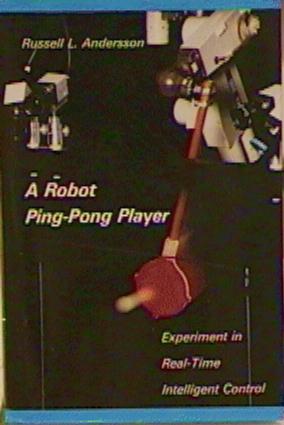|
A Robot Ping-Pong Player |
||||
|
This mid-80s work was originally presented as a book and videotape,
published by the MIT Press, but
they are now out of press. However, since the material remains a great gee-whiz
robotics experiment, I have made it available on a CD containing PDFs,
Postscript, and MPEG-1 video. Contact
Two years later, I had a working vision system, and in the meantime had created a system to control a PUMA 260 robot in C. Suddenly, the need for a demonstration of the potent capabilities of the work was upon me. For reasons no longer clear, but doubtless related to the simplicity of the resulting image, I threw together a system to catch a ping-pong ball rolling in 2-D across a table. The ping-pong ball had the advantage of being very white, and the ball would break rather than allow the robot to come to harm. After a subsequent explosion in the complexity of the code, the robot caught most of a certain class of trajectories with high reliability. It would even catch balls bounced off a piece of foam shortly before they were to be caught, amply demonstrating the true real-time nature of the system. It was clear, however, that catching the remainder of the balls would require more subtle strategies not easily captured in my program - it was likely that even trying would cause the whole thing to collapse under its own weight. Nonetheless, the demonstration was a vast success, and the volume of demonstrations prevented me from doing much additional work on the system, affording me the time for thought. Since I could catch in two dimensions, it only stood to reason that I should be able to do it in three. About this time, I heard of the challenge/contest announced by Professor John Billingsley of Portsmouth Polytechnic (U.K.) for robot ping-pong, and since I had already thought along these lines, his proposal provided an excuse for further ruminations. Some time later, I heard a rumor that Dan Kodeschek of Yale had thought of catching objects. I put off all consideration of ping-pong, and rushed to create a 3-D catcher, since I knew it should be straightforward. The resulting system proved able to catch balls in a styrofoam coffee cup, exhibiting some spectacular behavior due to primitive error recovery code. By this time, however, it was clear that I was going about this entirely the wrong way. Alarmingly, it appeared that if I attempted to extrapolate the system to full ping-pong, it was never going to work. There was not going to be a magic algorithm that could compute an ideal ping-pong player's response, as had been the attempt in the previous demonstrations. Trying to address the different cases was going to result in a nonfunctional morass; the line between when to apply one strategy and when to apply another was thin, bordering on nonexistent. What I had to do was to capture the subjective skills of a trained human. A person's skilled techniques appeared then, and now, equally applicable to a person playing ping-pong, or to a person working on an assembly line. In both cases, people make many clever motions, without seeming to expend much thought, and one can improve their performance by giving small hints such as ``keep your elbow up.'' By contrast, a robot would need a whole new algorithm. This book describes an experiment to try to capture this type of skilled behavior, resulting in a robot ping-pong player which can play and beat human players. Along the way to a working system, I discovered and had to solve many interesting problems. The vision system, the expert robot controller, the low-level robot controller, and the overall system design were significantly affected by the need to make the system respond accurately in a dynamic environment. At least one chapter is devoted to each of the four major subsystems above; each chapter describes what the subsystem must accomplish, how it does so and why, and quantitatively documents its performance. Although the book has the technical content of a work oriented at robotics professionals; computer scientists, physicists, hobbyists, and the technically curious should be able to read the book and gain insight into how the system works and is put together - and an appreciation of how good the human machine really is.
|
 The work described in this book is the result of a sequence of experiments that
began with the idea of building an honest real-time (60 Hz) vision
system.
The sight of a slick, high-tech robot plodding along at a snail's pace has always
rubbed me the wrong way.
John Jarvis originally pointed out that moments were a simple enough, and well
enough understood, computer vision operation that we really ought to be able to do
them faster.
They seemed well suited to making a vision system that was fast enough to serve
as a sensor for a fast robot, even if the scenes had to be quite simple.
I set off to make a vision system that would process simple scenes
quickly, rather than complex scenes slowly,
to investigate tightly coupled robot/vision systems.
The work described in this book is the result of a sequence of experiments that
began with the idea of building an honest real-time (60 Hz) vision
system.
The sight of a slick, high-tech robot plodding along at a snail's pace has always
rubbed me the wrong way.
John Jarvis originally pointed out that moments were a simple enough, and well
enough understood, computer vision operation that we really ought to be able to do
them faster.
They seemed well suited to making a vision system that was fast enough to serve
as a sensor for a fast robot, even if the scenes had to be quite simple.
I set off to make a vision system that would process simple scenes
quickly, rather than complex scenes slowly,
to investigate tightly coupled robot/vision systems.